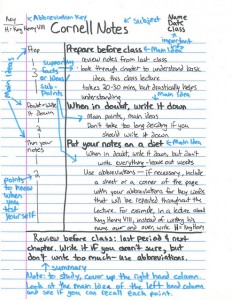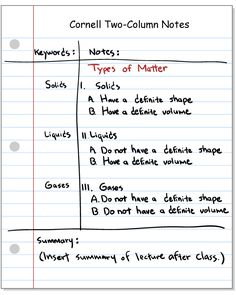CORNELL NOTE TAKING SYSTEM
Recall Column (See Cornell Notes Template below)
——2 1/2”——– —————-6”——————–
Reduce ideas and facts to
concise jottings and
summaries as cues for Record the lecture as fully and as
Reciting, Reviewing, meaningfully as possible.
and Reflecting.
The format provides the perfect opportunity for following through with the 5 R’s of note-taking and reinforces the SQ3R Reading Methodology. Here they are:
- Record. During the lecture, record in the main column as many meaningful facts and ideas as you can. Write legibly.
- Reduce. As soon after as possible, summarize these ideas and facts concisely in the Recall Column. Summarizing clarifies meanings and relationships, reinforces continuity, and strengthens memory. Also, it is a way of preparing for examinations gradually and well ahead of time.
- Recite. Now cover the column, using only your jottings in the Recall Column as cues or “flags” to help you recall, say over facts and ideas of the lecture as fully as you can, not mechanically, but in your own words and with as much appreciation of the meaning as you can. Then, uncovering your notes, verify what you have said. This procedure helps to transfer the facts and ideas of your long-term memory.
- Reflect. Reflective students distill their opinions from their notes. They make such opinions the starting point for their own musings upon the subjects they are studying. Such musings aid them in making sense out of their courses and academic experiences by finding relationships among them. Reflective students continually label and index their experiences and ideas, put them into structures, outlines, summaries, and frames of reference. They rearrange and file them. Best of all, they have an eye for the vital-for the essential. Unless ideas are placed in categories, unless they are taken up from time to time for re-examination, they will become inert and soon forgotten.
- Review. If you will spend 10 minutes every week or so in a quick review of these notes, you will retain most of what you have learned, and you will be able to use your knowledge currently to greater and greater effectiveness.
10 Steps of the CORNELL WAY
| C | Create Format | Step 1: Create Cornell notes format and complete heading (See Cornell Note Template below) | Set up your paper |
| O | Organize Notes | Step 2: Organize notes on the right side. | Take notes on the most important info |
| R | Review and Revise | Step 3: Review and revise notes. | Review and revise |
| N | Note Key Ideas | Step 4: Note key ideas to create questions. | Ask questions about your notes |
| E | Exchange Ideas | Step 5: Exchange ideas by collaborating | Compare notes with a partner and revise |
| L | Link Learning | Step 6: Link learning to create a synthesized summary. | Write a summary |
| L | Learning Tool | Step 7: Use completed Cornell notes as a learning tool.
|
Use your notes to study |
| W | Written Feedback | Step 8: Provide written feedback as part of your Revision.
|
Review your written feedback |
| A | Address Feedback | Step 9: Address written feedback.
|
Set goals based on your feedback |
| Y | Your Reflection | Step 10: Reflect on your learning | Write a reflection |
Use Abbreviations in your Cornell Note-Taking
P = page
# = number
b/c = because
b/4 = before
wd = word
w/ = with
w/o = without
2 = to, too, two
ie = that is
eg = for example
re = concerning
vs = versus
~ = about
> = greater than
< = less than
T = could be on the test
Cont’d = continued
→ = means
∴ _= therefore
√ = check later
* = important
def = definition
$ = money
e’day = everyday
HW = however
Gov’t = government
Int’l = international
Q = question
ch = chapter
Write only the beginning of a word:
Ref = reference
Dif = difference
Comp = compare
Write only consonants and omit vowels:
Impt = important
Bhvr = behaviour
Wrt = write
Lrn = learn
Lk = like


